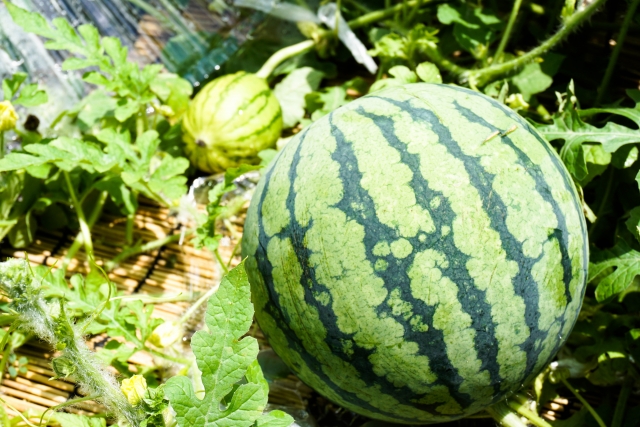
When it comes to summer, the quintessential fruit is the watermelon, although technically, it’s actually a type of vegetable. Despite being a vegetable, watermelons are sweet, delicious, and perfect for hydration, making them a delightful summer treat. Inside the watermelon, you’ll find plenty of black seeds.
Ever wondered what would happen if you planted those seeds after enjoying your watermelon? I certainly have, and curiosity has gotten the better of me. So, let’s give it a try.
In this guide, I’ll introduce you to the process of growing watermelons from seeds. Will the seeds sprout if planted? Let’s find out.
Is it difficult to grow tomatoes from seeds? Methods for germinating tomatoes from seeds

- Collecting the Seeds from Eaten Watermelons
- Dry the watermelon seeds for about half a day when storing
- Sow the watermelon seeds by covering them lightly with soil
- 4 days after sowing watermelon seeds: Germination has already begun
- After 7 days, the watermelon seeds have grown to the point where the cotyledons are about to open
- 8 days after watermelon seed germination: Incredible elongation in just one day
- Watermelon seeds from consumed fruit can sprout and grow
Collecting the Seeds from Eaten Watermelons
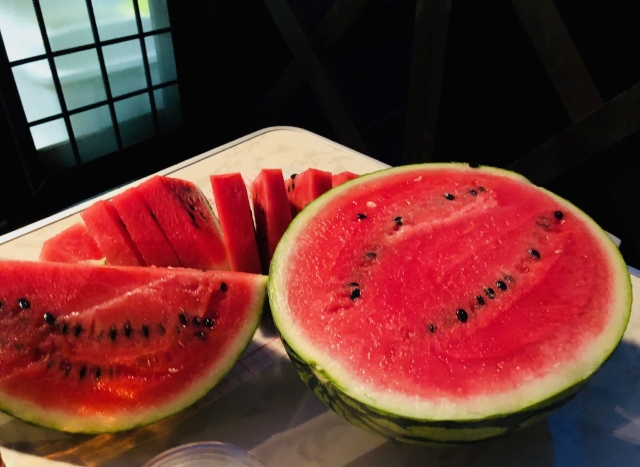
First, start by enjoying the watermelon to collect the seeds.
Gather the Watermelon seeds after eating, and clean them thoroughly to remove any flesh.
Then, soak the watermelon seeds in water for about a day, and separate the seeds that sink from those that float.
Seeds that float are likely incomplete and should not be used.
- Sinking watermelon seeds: These are well-developed and more likely to germinate.
- Floating watermelon seeds: These are incomplete and less likely to germinate.
Unlike seeds of other vegetables, watermelon seeds are large, so there’s a high probability that floating seeds are not viable.
Dry the watermelon seeds for about half a day when storing
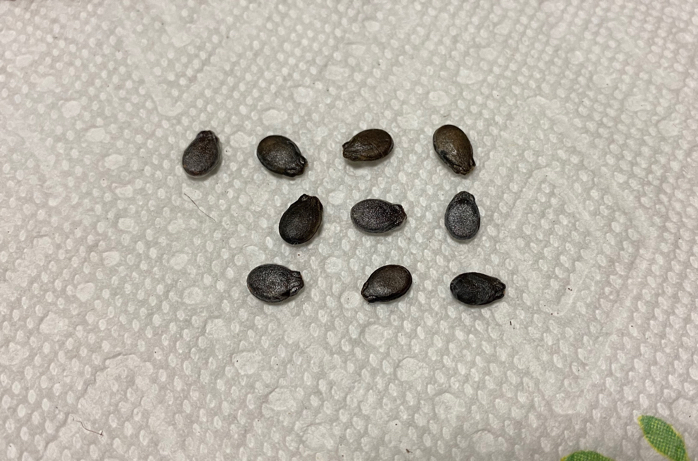
The time when you’re eating watermelon is honestly a bit late to start growing it. Therefore, after soaking and selecting the seeds for next year’s cultivation, dry them for about half a day.
If you’re storing the seeds until the next year, it’s best to keep them in the refrigerator. Since moisture can cause mold, include a desiccant. I found that many of the seeds I saved after eating developed mold, so it’s crucial to ensure they are dry.
- STEP1Remove the watermelon flesh and soak the seeds in water
- STEP2Sort the Watermelon seeds into sinking and floating ones
- STEP3Dry the sinking Watermelon seeds to some extent.
I included this step to remove any mold. However, there’s still some doubt about whether the seeds from eaten watermelons will actually germinate. So, this time, I’ll sow 10 seeds to check the germination rate.
Sow the watermelon seeds by covering them lightly with soil
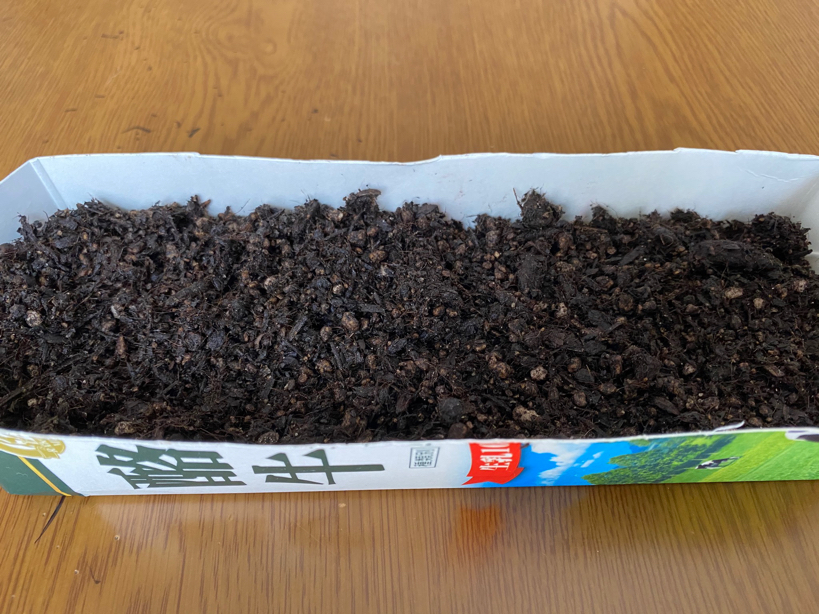
Watermelon seeds are photophobic, meaning they have difficulty germinating when exposed to light. Therefore, after sowing watermelon seeds, cover them lightly with soil to prevent sunlight exposure.
It’s important not to sow them too deeply, with around 1 cm of soil covering as a guideline. However, I wanted to observe the germination process of watermelon seeds more closely, so I opted to sow them on dampened kitchen paper and placed a piece of cardboard on top to block light exposure for observation.
Both methods can be used to germinate watermelon seeds, but it’s crucial to remember their photophobic nature and ensure that they are shielded from light.
4 days after sowing watermelon seeds: Germination has already begun
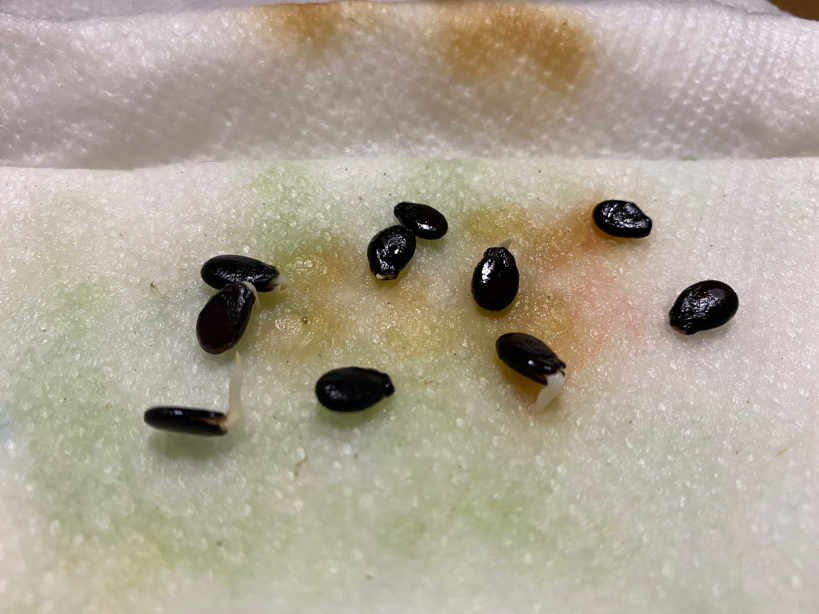
Despite some discoloration and dirt, upon checking the kitchen paper four days after sowing the watermelon seeds, I noticed white sprouts emerging, indicating germination has begun. While larger seeds typically take longer to germinate, it seems watermelon seeds germinate quite quickly.
Out of the 10 seeds I planted, it appears that 6 of them have begun germinating, resulting in an impressive germination rate of 60% at this stage. Hopefully, the remaining 4 seeds will also sprout soon.
After 7 days, the watermelon seeds have grown to the point where the cotyledons are about to open
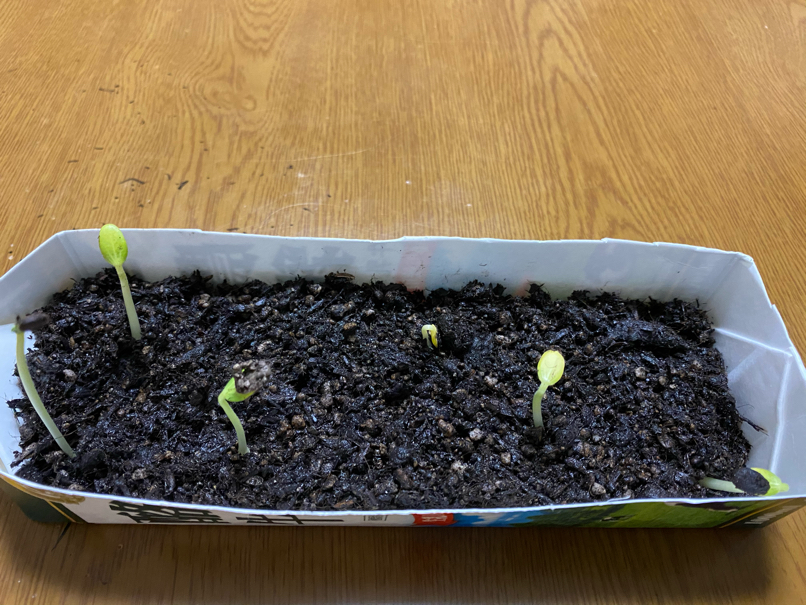
The process of watermelon seed germination was observed on the kitchen paper, which made it easy to monitor. Once the germination was confirmed, they were transferred onto shallowly prepared soil in milk cartons.
Based on past experience, germinating seeds solely on kitchen paper tends to result in slower growth. Therefore, I promptly transplanted them into soil. This seemed to have a positive effect as the germinated watermelon seeds showed rapid growth.
It’s quite surprising to see such significant growth in just one week since sowing. Watermelons must be rapid growers, huh? Looking forward to their further growth from here on.
8 days after watermelon seed germination: Incredible elongation in just one day
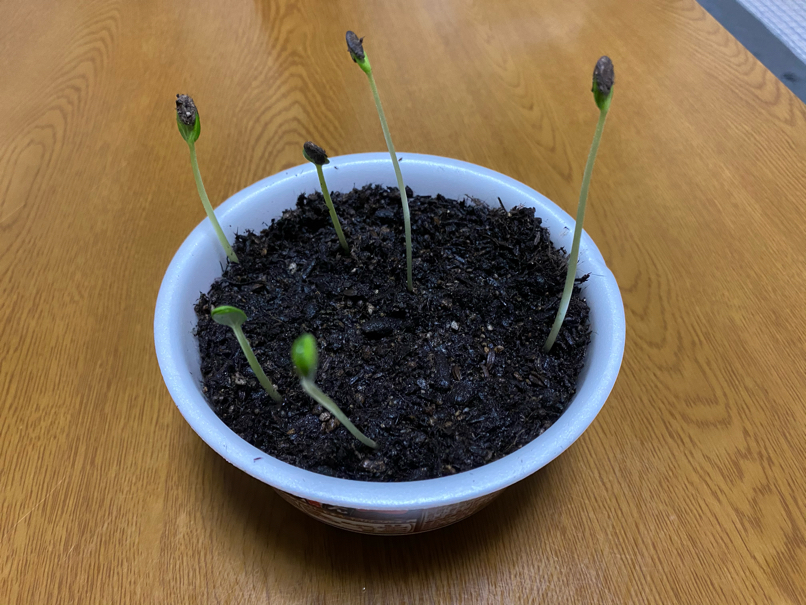
I tried to improve the environment a bit by transferring the germinated watermelon seeds to an instant noodle cup container serving as a seedling pot.
However, the next day, they elongated excessively… They looked just like daikon sprouts, didn’t they?
Hmm, could it be because there was too much moisture and they didn’t get enough sunlight? Anyway, this year’s goal was simply to confirm that the watermelon seeds from last year’s fruit would germinate, so it’s not a problem. But I’ll need to be more careful next year when I start serious cultivation.
Watermelon seeds from consumed fruit can sprout and grow
This time, I introduced the method of sprouting watermelon seeds.
Watermelon is a fruit we almost always eat during the summer, characterized by its abundance of black seeds.
Usually, we just discard these seeds, but wouldn’t it be great if we could sprout them and grow seedlings?
Watermelon seedlings can be surprisingly expensive to buy, and it’s difficult to get a large quantity. However, if we can sprout the seeds from eaten watermelons, we could potentially prepare a large number of seedlings. Of course, the issue of where to plant them remains…
Since it was already August when I started planting the seeds, the main focus of this experiment was simply to see if the watermelon seeds would sprout. However, they sprouted unexpectedly quickly and are growing rapidly, so I’ll continue to monitor their progress to see how far they go.
Knowing that we can sprout and grow watermelon seeds from deliciously eaten fruit, I encourage everyone to give it a try.
How to make seedlings of the sweet potato

How to take seeds of ripe cucumber

【For Beginners】How to Bell Peppers from Seeds



コメント